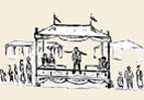|
Mendon — The Early Years
Brigham Young
Carpenter and Cabinet Maker
by
Brigham Young was born at Whitingham, Windham County Vermont, on the first
day of June 1802, the ninth of eleven children of John and Abigail Howe Young.
When Brigham was two, the family moved westward into central New York. They
first settled in Sherburne in Chenango County, then moved to Aurelius in Cayuga
Couinty, and later to Tyrone township in Ontario County.
Following the death of his mother in 1815 and his father's marriage in 1817
to Hannah Brown, a widow with two children, Brigham left Tyrone to live with
his sister in Auburn, New York.
In that city Brigham was apprenticed to Thomas Jeffries, a cabinetmaker where
he learned the trades of a carpenter, joiner, glazer, and painter. Over the
next five years he assisted in building the first marketplace, the Aubrun Prison,
the theological seminary, and the home of "Squire" William Brown
(later occupied by William H. Seward, a governor of New York who also served
as Lincoln's Secretary
of State).
As a master carpenter, Brigham built door fittings, louvered attic windows,
and carved ornate mantelpieces for many homes. Numerous old homes in the Auburn
region contain many of his chairs, desks, staircases, doorways, and mantelpieces.
Brigham left Auburn in the spring of 1823 to work in Port Byron, New York,
where he repaired furniture and painted canal boats. He developed a device
for mixing paints and turned out many chairs, tables, settees, cupboards,
and doors. He also helped organize the local forensic and oratorical society.
On October 5, 1824, at the age of twenty three, Brigham married eighteen-year-old
Miriam Angeline Works. Their first child, Elizabeth, was born in Port Byron
on September 26, 1825. From Port Byron, Brigham and his wife moved to Oswego,
a port on Lake Ontario. Four years later the couple joined Brigham's father
in the Town of Mendon, Monroe County, New York State.
The father, John Young, was the first of the family to come to Mendon. On
February 23, 1827, he purchased eight acres of land from William Allen, and
on April 8, 1830, forty acres from Marvin and Eliza Burton. The combined acreage
occupied the northeastern and southeastern corners of the intersection of the
Cheese Factory and Mendon-Ionia Roads.
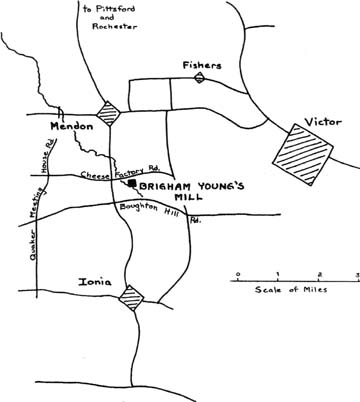
Map drawn by J. Sheldon Fisher showing location of
the Young Mill.
On Trout Creek at the east end of his father's farm, Brigham constructed a
building, the second floor for his house and the first floor for his wood
working shop. He built a dam on the creek in order to provide power for the
workshop. The property, including the early house of John Young and the site
of the former shop/house of Brigham Young, is now owned by the Church of the
Latter Day Saints (Mormons) and is visited every year by members of that fairth.
(Author's Note: The word "Mormon" is derived from an Egyptian word "Mon" meaning
good, prefixed by the contraction "mor" for more, making the complete word
mean "more good."
For much of the information about Brigham Young's mill site and the years
he spent in Mendon, I am indebted to the late J. Sheldon fisher, the noted
historian who created the Valentown Museum in the town of Victor, Ontario County.
I consider myself fortunate that I knew Sheldon and was able to absorb some
of his knowledge of local history.
In 1972 Sheldon Fisher obtained exclusive digging rights at the Young shop
site from owner Robert Hutchinson. He then began an archeological investigation
that would lead to additional information about Brigham Young's years in Mendon,
and hopefully provide fresh insights into his life and character during the
time that he began his great spiritual adventure.
The following excerpts are from an article in the October 1980 issue of
New York History Magazine in which Mr. Fisher described how he excavated
the site of the Young mill and determined its physical layout in relation to
the
creek on which it was located:
"As a first step, I staked out the site in a grid of ten foot squares,
starting at a spike I drove into a tree at the northeast end of the dam.
Exploratory
test holes in the area where the building was supposed to have been revealed
nothing. But at the edge of the field near the creek bank I found a pothook
used to hold kettles on a fireplace crane. Fragments of dishes and pottery
were everywhere. A long trench was dug and the sifted soil was thrown back
into a pile for a second sifting when it had dried out. By the end of six
summers, I had exposed the foundations of the building which measured 45
feet long by
20 feet wide.
"In all of my experiences, I had never before seen or heard of a building
being built in a stream bed as this was. Here, still preserved, were the
foundation timbers shaped by a broad ax and smoothed off by an adz. The sills
of the building
on the field side had rested on large boulders and were rotted away because
they
were not covered by mud or water.
"The upstream end of the building was about four feet from the dam
which still reveals the bottom logs and the heavy supporting boulders. A
headgate
controlled the amount of water that flowed down a plank flume under the
building to a three-foot-wide water wheel housed inside near the downstream
end of the
building. The waterwheel spun over a wide board which prevented the water
from gouging gravel under the waterwheel and losing pressure. A four-foot
head of
water operated the undershot waterwheel.
"The waterwheel was mounted on a heavy axle of hewn oak timbers, parts
of which were well preserved in the mud. This frame was mortised and tenoned
into the foundation timbers, which were still visible. It would follow,
that because of its size, the waterwheel could have projected through the
floor
into the first floor shop. Shafts and belts operated the saws, grindstone,
and the two lathes, one for metal work and the other for wood turning.
There were trap doors in several places in the shop floor where the working
debris
was swept into the water.
"Near the north west corner of the building was located a fireplace
serving the first floor shop and the second floor dwelling. A part of the
first floor
fireplace was a forge for blacksmith type work. The fire place interiors
were built of brick evidently made by Brigham Young on the spot as a pile
of red
clay and waste fragments of brick were found. His initials were cut into
some bricks when the clay was soft before the bricks were baked."
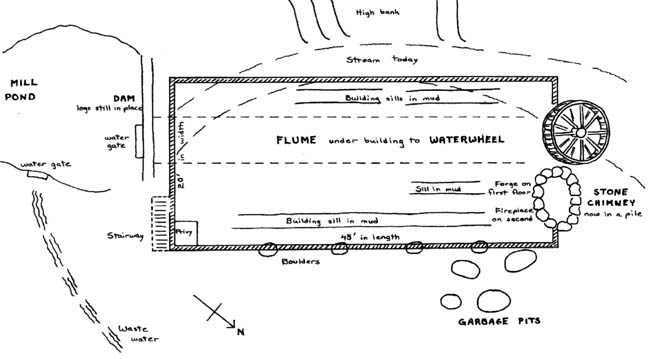
Sketch of Brigham Young's mill by J. Sheldon Fisher
based on his excavation
of the site.
(I recall that many years ago Sheldon Fisher told me that Brigham Young's
building was dismantled and rebuilt as a dwelling on Malone Road in the town
of Victor.)
In April of 1830, Samuel Smith passed through Mendon on a missionary journey
to distribute copies of the Book of Mormon written by his brother
Joseph Smith, Jr., the founder of Mormonism. He left a copy with Brigham's
brother Phineas,
an itinerant preacher for the reformed Methodist Church. Phineas was favorably
impressed with the book and lent it to his father,
then to his sister Fanny, who gave it to Brigham.
Though impressed, Brigham nevertheless counseled caution: "Wait a little
while…I want to see whether good common sense is manifest." (Journal
of Discourses 3:91 8:38). After nearly two years of investigation,
Brigham, moved by the testimony of a Mormon elder, Eleazer Miller, was baptized
on April 15, 1832
(Journal of Discourses 13:211). All of Brigham's immediate family
were also baptized and they remained loyal Latter Day Saints throughout their
lives.
One week after his baptism, Brigham gave his first sermon. He declared: "After
I was baptized I wanted to thunder and roar out the gospel to the nations.
It burned my bones like fire pent-up, so I commenced to preach. Nothing would
satisfy me but to cry abroad in the world, what the Lord was doing in the latter
days." (Journal of Discourses 1:313).
Brigham's wife, Miriam, who suffered from chronic tuberculosis and was a semi
invalid, lived only until September 8, 1832. He felt the impulse to "cry
abroad"
so strongly that he enlisted the assistance of his Mendon neighbors, Vilate
and Heber C. Kimball, to care for his daughters and abandoned his carpenter
trade to devote himself wholeheartedly to building the "Kingdom of God."
In the fall of 1832 Brigham, his brother Joseph, and Heber Kimball, traveled
from Mendon to Kirtland, Ohio, where he met the twenty-six-year-old Joseph
Smith for the first time. Brigham later wrote "my joy was full at the privilege
of shaking the hand of the prophet of God—he was happy to see us and bid us
welcome. In the evening a few of the brethren came in, and we conversed together
upon the things of the Kingdom. He called upon me to pray. In my prayer I spoke
in tongues. As soon as we rose from our knees, the brethren flocked around
him and asked his opinion—he told them it was the pure Adamic language. It
is of God and the time will come when Brigham Young will preside over the church."
Brigham's subsequent missionary tours carried him north, east, west, and
south of Mendon. He and his brother made several preaching trips into many
areas of
New York State and upper Canada. In the summer of 1833 he traveled to Kirtland
with several of his Canadian converts, where he heard Joseph Smith preach about
the gathering of the Saints, emphasizing that building the Kingdom of God required
more than preaching. Thus instructed, Brigham returned to Mendon and, with
the Kimball family, moved
his household to Kirtland so he could participate in building a new society.
Among those whom Brigham met in Kirtland was Mary Ann Angell, a native of
Seneca, Ontario County, New York, who had worked in a factory in Providence,
Rhode
Island, until her conversion to the Mormon Church and her move to Kirtland.
Brigham married her on February 16, 1834. She looked after Brigham's two daughters
by his first wife and subsequently had six children by him.
Mary Ann was the second of twenty-seven women who Brigham married over a period
of sixty-two years. During this time he fathered fifty-seven children. His
last wife was twenty-three-year-old Ann Eliza Webb who he
married on April 6, 1868, at age sixty-six..
My research into the life of Brigham Young during his years in Mendon, and
the years prior to his move to that town, have revealed conflicting accounts
of his character. During his four-year residence in Oswego it has been recorded
that he added to his reputation for good craftsmanship, trustworthiness, and
industry. An Oswego associate testified that his "conduct was exemplary,
humble and contrite."
An article in Volume Five of the Rochester Historical Society Publication
Fund Series, dated 1926, mentions that shortly after Young's arrival in
Mendon, he was employed for a time by Captain George Hickox in the Town of
Canandaigua. The article further states that Hickox family has specimens of
his handiwork, including a well made splint-bottomed chair. According to family
tradition, Brigham was an industrious, willing worker, serious minded, and
earnest.
In a letter to Captain Hickox, written from Salt Lake City in 1876, the then
president of the Mormon hierarchy spoke of his amusement and interest at hearing
that an article made by him fifty years before was to be exhibited at a fair
for the benefit of a new school. He also stated that: "I have believed all
my life that what was worth doing was worth doing well and have considered
it as much a part of my me, as to attend the services of God's worship on the
Sabbath."
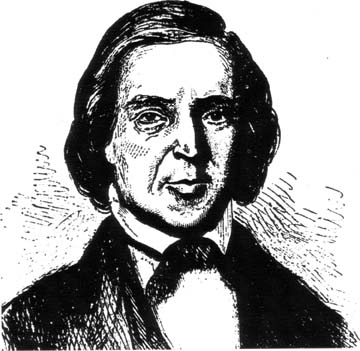
Governor Brigham Young of the Utah Territory
From Harper's Weekly, July 11,
1857
On August 11, 1926, the Hon. John D. Lynn, formerly a resident of Mendon wrote
the following letter in response to an inquiry by the editor of the Rochester
Historical Society's Publication Series: "You load me with patriarchal dignity
in assuming I have any personal memory of Brigham Young. I have, however,
some memory of local gossip quite active in my childhood. Though generally
communicated in confidential undertones, as Brigham was not one in whom his
fellow townsmen took great pride, and when he went away with the Mormon movement,
he took with him others from the neighorhood, to the end that a number of Mendon
families had a member or two with that forceful sect whom they never mentioned
and even gossip respected their feelings.
"Brigham was considered by his yeoman neighbors a sort of vagabond, a
'ne'er-do-well,' who would stop in the middle of any job, to argue the Scriptures,
particularly
as to their authority for minute differences of faith and practice.
He was an attendant of the Baptist Church in the building that, until recently,
stood upon the hilltop just south of Mendon Village. Whether he was an actual
member of that Church is uncertain, and if he were, it was prinipally for argumentative
purposes, never being able to agree with his brethren on the proper hardness
of a shell. He was something of an Evangelist and, until he found the 'true
faith,' wandered from sect to sect with more activity than welcome.
"He was the first glazier in the neighborhood, and many of the old houses
on the town have glass in their windows that was set by him.
"He could also make baskets and splint chairs, and from this vocation
principally he supported himself. His work was durable, and Brigham's chairs
are today
found in many of the parlors of the town, cherished less for their beauty
than for their historic interest.
"When Brigham became leader of the Mormons, his chief minister of state was
another Mendon man, Heber C. Kimball, who, before he became a Latter Day Saint,
ran a blacksmith shop about a mile south of Brigham's house on the Mendon-
Ionia Road."
Also, I have in my files a copy of an undated account, written some years
after Brigham Young's departure from Mendon, by George W. Allen who knew Young
when
he was a resident of the town. In this account Allen describes how Brigham
employed devious means to extort money and materials from his neighbors.
Allen further stated that "Brigham in his habits was essentially lazy,
so far as labor was concerned, and an unprofitable hand to employ. He would
shirk
the hard and most laborious work, if possible, and would surely cut the day
short at both ends of it, and render some plausible excuse of family sickness
or religious engagement as a reason for his absence. He had an appetite for
dainties and delicacies and would generally indicate to the housekeeper where
he worked, such food and drink he desired, accompanied with a very persuasive
request that they be provided for his use while he worked there."
Doctor Milton Sheldon was the owner of a general store in Mendon and the future
brother-in-law of George W. Allen. In 1829 when Allen was a young man, Doctor
Sheldon sent him to Brigham Young's house to collect a store debt of $18.50.
In his own words he described this visit: "It was a cold windy day when
warm clothing and good fires were a necessity. His house and shop stood some
eighty
rods from the highway, nothing but a foot path led to it. Leaving the horse
I rode at the bars on the highway, I followed this path which lay along by
the side of a beautiful little stream of clear water noted for the speckled
trout that it contained. A dam had been thrown across this stream and sufficient
water power obtained to run a turning lathe in his shop.
"On arriving at the house and shop I ascended a rickety outside stair case
and was bidden to come in. Pulling a leather string lifted a wooden latch,
enabled
me to open the door and I entered. Everything about the house inside and out
indicated poverty and destitution. There was only one room which served for
bedroom-kitchen-sitting room and parlor. There was a bed in one corner, a cupboard
for dishes in another, a table and a few splint bottom chairs. Mrs. Young was
poorly dressed and thinly clad, having an old black shawl thrown around her
shoulders, endeavoring to keep warm over a single stick of wood on fire in
the fireplace. She was evidently in very feeble health. The only other person
was a little red haired girl five or six years old, with a basket gatherng
chips and bits of wood for fuel. This girl is now the wife of a Mormon dignitary
who stands high in the community.
Mrs. Young said that her husband had gone to Miller's Corners (now Ionia)
to attend a quarterly or a 'four days meeting' and she did not know when to
expect him home. An influence that could entice him away from a sick and suffering
wife and infant family, destitute of the ordinary comfort of life, and cause
him to remain night and day for three or four days almost in sight of home
while he was enjoying the hospitalities of his brethren—exhorting, praying
and singing, the ''loudest of the crowd' and having a 'glorous time' at a religious
meeting.
"I made known my errand to her. She replied 'I do not know how or when
Mr. Young can pay Dr. Sheldon; he has been gone two or three days and left
us without
fuel. The last stick is on the fire; we have no flour or meat nor anything
else in the house to eat. As soon as he comes home, he will first have to provide
fuel and provision for the family. Dr. Sheldon will have to be patient a little
longer.' I left the house saddened by this exhibition of poverty, physical
and mental sufferings and in deep sympathy for the trials she endured, and
with no very exalted opinion of Brigham Young or his religious sincerity."
Several years ago Edwin Bachmann found in his house on Maplewood Avenue in
Honeoye Falls an 1829 account book for the general store in Mendon operated
by Dr. Milton Sheldon. Mr. Bachmann generously donated the book to the Honeoye
Falls / Mendon Historical Society. In this account book are entries for purchases
on credit made by Brigham Young. It is possible that they are the purchases
for which George Allen attempted to collect payment when he made his visit
to the Young House.
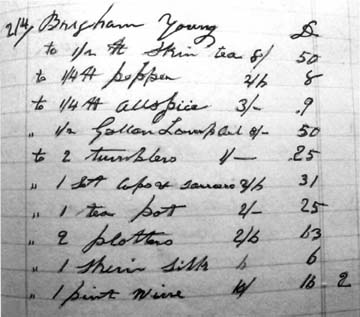
Page from account book of the Mendon General Store of Dr. M. Sheldon listing
purchases made by Brigham Young on October 2nd, 1829.
The primary focus of this article has been the years that Brigham Young spent
in Mendon with a brief mention of his earlier life. For an account of his life
after his departure from Mendon, there are numerous books that describe his
journey westward to Utah and his eventual elevation to the leadership of the
Mormon Church.
Sources of Information
J. Sheldon Fisher (verbally and in written form)
New York History Magazine,
October 1980
Rochester Historical Society Publication Fund Series, Volume IV
"Brigham
Young & Mormonism" by George W. Allen, undated
|
